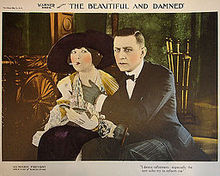The Beautiful and Damned (film)
| The Beautiful and Damned | |
|---|---|
 lobby card | |
| Directed by | William A. Seiter |
| Screenplay by | Olga Printzlau |
| Starring | Kenneth Harlan Marie Prevost |
Production company | |
| Distributed by | Warner Bros. |
Release date |
|
Running time | 70 minutes |
| Country | United States |
| Languages | Silent English intertitles |
The Beautiful and Damned is a 1922 American silent drama film directed by William A. Seiter and released by Warner Bros. The film, based on the F. Scott Fitzgerald novel The Beautiful and Damned, starred Kenneth Harlan and Marie Prevost.[1]
Production
To publicize the film, Jack L. Warner, announced that the film's stars, Kenneth Harlan and Marie Prevost, would marry on the film's set. The publicity stunt worked and thousands of fans sent gifts and letters to the couple. However, Warner was unaware that Prevost was still secretly married to her first husband, Sonny Gerke. The Los Angeles Mirror got wind of Prevost's first marriage and ran a story with the headline "Marie Prevost Will be a Bigamist if She Marries Kenneth Harlan". Warner was livid over the negative publicity and Prevost's failure to disclose her first marriage despite the fact that the publicity stunt was his idea. Warner quickly arranged an annullment and, when the publicity surrounding the scandal died down, Prevost and Harlan were quietly married.[2]
Reception
The film did well at the box office and critics were generally favorable. F. Scott Fitzgerald, however, disliked the film. He later wrote to a friend stating, "Its by far the worst movie I've ever seen in my life-cheap, vulgar, ill-constructed and shoddy. We were utterly ashamed of it."[3][4]
Preservation status
The film is currently listed as a lost film,[5][6][7] Warner Bros. records of the film's negative have a notation, "Junked 12/27/48" (i.e., December 27, 1948). Warner Bros. destroyed many of its negatives in the late 1940s and 1950s due to nitrate film pre-1933 decomposition. In February 1956, Jack Warner sold the rights to all of his pre-December 1949 films to Associated Artists Productions, then, in 1969, UA donated 16mm prints of some Warner Bros. films from outside the United States. No copies of The Beautiful and Damned are known to exist.
References
- ^ Tate, Mary Jo (2007). Critical companion to Fitzgerald. Infobase. p. 36. ISBN 0-8160-6433-4.
- ^ Foster, Charles (2000). Stardust and Shadows: Canadians in Early Hollywood. Dundurn Press Ltd. pp. 303–304. ISBN 1-55002-348-9.
- ^ Tate, Mary Jo. Critical Companion to F. Scott Fitzgerald: A Literary Reference to His Life and Work. Infobase Publishing. p. 32. ISBN 1-438-10845-1.
- ^ Ankerich, Michael G. (2010). Dangerous Curves atop Hollywood Heels: The Lives, Careers, and Misfortunes of 14 Hard-Luck Girls of the Silent Screen. BearManor. p. 287. ISBN 1-59393-605-2.
- ^ "Progressive Silent Film List: The Beautiful and Damned". silentera.com. Retrieved April 12, 2013.
- ^ The Library of Congress American Silent Feature Film Survival Catalog:The Beautiful and Damned
- ^ 1957 MOVIES FROM AAP Warner Bros Features & Cartoons SALES BOOK DIRECTED AT TV
External links
